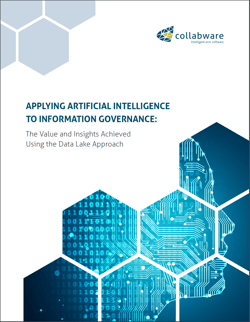
Image courtesy of Adobe Stock photos.
The drive to leverage artificial intelligence (AI) for increased human efficiency and effectiveness has never been stronger. According to a report done by the McKinsey Global Institute, 70% of companies are likely to have adopted at least one type of AI technology by 2030. While there are many possible applications of AI for increasing operational effectiveness, information management (IM) is an area with potential for an immediate increase in efficiency.
We’ve already spoken about what AI is. Today, we’re covering why and how your organization should apply AI to your IM/information governance practices. We’ve also published a white paper detailing this topic, plus key challenges with implementation, how to address them, a tool to make it happen and three use case scenarios showcasing benefits. You’ll be able to download it for free, below.
For now, let’s talk AI for IM.
Why Should My Organization Apply AI to their IM?
We are living in an Artificial Intelligence Economy. What does this mean? Well, as the volumes of available information grow, organizations and individuals are taking advantage of AI in their toolkits. And while there are many possible applications of AI for increasing operational effectiveness, the domain of IM is an area with potential for an immediate increase in efficiency.
The primary motive to harness AI with IM activities is to address these exponential volumes of content being created, combined with the need to meet legislative and regulatory requirements. This combination creates a drain on productivity within organizations, making it extremely difficult to maintain transparency and leading to increased time spent trying to identify information needed for organizational activities. For example, another McKinsey report found that employees spend an average 1.8 hours every day searching and gathering the information they require. This totals to over 9 hours a week just searching for necessary content.
Let's put it simply: the increasing volumes of content are exceeding humanity’s natural ability to process. This creates a great opportunity where AI can assist.
By applying AI to IM, organizations can accelerate digital transformation through automation of digital activities such as content classification and supervision (we dive into these and other benefits in our whitepaper, which you can freely download below).
How Can My Organization Apply AI to IM?
While it may seem simple in concept to apply AI to the IM ecosystem, there are some inherent challenges that arise. Some include disparate technology stacks that limit enterprise-wide views and legacy storage systems that do not account for the parallel processing required for AI. How can your organization navigate these to apply and benefit of automation to your IM?
To progress with the application of AI to IM practices, these obstacles must be addressed by any solution seeking to help drive digital transformation. Effectively applying AI to the IM domain requires a solution to manage distributed information within a compliance-focused infrastructure capable of supporting massive parallel computing.
It is with this methodology in mind that Collabware pioneered the Data Lake Approach to Cross-System Information Management. This approach enables content from multiple systems to be streamed (constantly crawled) into a data lake.
The data lake centralized IG engine, Collabspace, is a step up, being that it comes pre-built with many features including complete end-to-end content lifecycle automation, advanced eDiscovery, backup and more. It supports the massive parallel compute activities needed for advanced AI processing.

Some benefits include:
• Operation of connected systems and related user activities are unaffected. Streaming snapshot versions of content into the data lake is a transparent, near real-time activity. Users continue working with the original content version in the original system.
• The data lake leverages secure Write Once Read Many (WORM) storage that immediately protects the content and enables insights to be derived from content over time. This enhances the learning models and decreases the amount of manual supervision required.
• The learning models can be created based on an entire corpus of organizational content, which dramatically increases the accuracy of classification and content enrichment activities.
...And more that will be covered you can read about in our white paper!
AI Value for IM
In summary, the large volumes of data that organizations must manage provide opportunity to leverage AI for increased efficiency and meeting regulatory requirements. While factors such as disparate technology stacks and legacy storage bring challenges, organizations can create an AI foundation for their IM by implementing the Data Lake Approach to Cross-System Information Management. By selecting the correct data lake solution, content can be streamed in from multiple systems for benefits such as automated content indexing, discovery capabilities, and more.
Teams will then be able to work on their day-to-day tasks unaffected while AI supports seamlessly in the background.
Interested to read the full story? Download our white paper on the topic below for free! If you'd like to chat with our team of experts on making this happen for your organization, please reach out to us.

Want to read more? How about checking out our blog article explaining AI, or defining the data lake? Also, subscribe to our blog to see the latest and greatest in information governance and solution updates!





